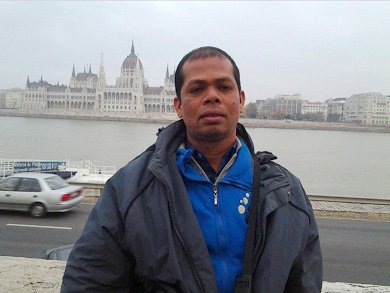Today's Women in Terrorism
Abstract
The role of women in acts of terrorism is increasingly varied from just helping to hide terrorist escapees, intelligence activities even only being used by terrorist networks. This paper looks at the root of the problem in uncovering the increasingly diverse roots of terrorism radicalism. This article uses qualitative research methods with research variables namely terrorism ideology, women, and internet technology. The results of this study indicate that those who fall into this because of family factors and it is undeniable that family factors have a tremendous influence on the way of thinking and behaving in general, those who are members of this radical act of terrorism, their families have been one of the terrorists or terrorist accomplices. or understand radicalism after that environment, and information technology. In addition to the emptiness factor (lack of love, their presence is not accepted, while radical groups seem to accept it very well. And other factors are educational and economic factors, in this case they are terrorists who guarantee their daily needs provided they remain loyal and risking their lives to comply with all regulations.
Keywords
Full Text:
PDFReferences
“12 Scientific Reasons Why Someone Becomes a Terrorist, These Are Their Thoughts”, IDN Times, 2021, https://www.idntimes.com/science/discovery/viktor-yudha/12-alasan-ilmiah-why-seseorang-be- terrorist/7, accessed June 25, 2021.
“Polri: Female Terror Suspect in Purworejo Bride and Groom”, CNN Indonesia, 2016, https://www.cnnindonesia.com/nasional/20161219142630-12 -180707/polri-perempuan-tersangka-teror-di-purworejo-calon-pengantin, accessed June 26, 2021.
"It's Been There For a Long Time, Here's the History of Terrorism", MataMata Politics, 2020, https://www.matamatapolitik.com/ in-depth-historis-already-ada-sejak-lama-begini-sejarah-terorisme/, accessed June 25, 2021.
… http://ditjenpas.go.id
Ancok, D. (2008). Injustice as a source of radicalism in religion: An analysis based on the theory of justice in a psychological approach. Indonesian Journal of Psychology, 1, 1-8.
Arikunto, Suharsimi. (2012).Research Procedure A Practical Approach, Jakarta: Rineka Cipta.
Aritonang, JS (2006). The history of the encounter of Christianity and Islam in Indonesia. Jakarta: BPK Gunung Mulia.
Atran, S. (2004). Trends in suicide terrorism: Makes sense and doesn't make sense. Scientific presentation at the World Federation of Scientists Permanent Monitoring Panel on Terrorism, Erice, Sicily, August 2004. Downloaded from http://sitemaker.umich.edu/satran/files/atran-trends.pdf.
Cheri, K. (2012). What are heuristics? Downloaded from http://psychology.about.com/od/hindex/g/heuristic.htm.
Druckman, D. (2001). Nationalism and War: A socio-psychological perspective. In DJ Christie, RV Wagner, DDN Winter (Ed.), Peace, conflict, and violence: Peace psychology for the 21st century (49-65). New Jersey: Prentice-Hall.
Ehrlich, PR, Liu, J. (2002). Some roots of terrorism. Population and Environment, 24(2), 183-192.
Fenton, AJ (2014). Change and continuity of Indonesian Islamic ideology and terrorist strategy.Al-Jami'ah: Journal of Islamic Studies,52(1).
Kahneman, D. (2002). Map of finite rationality: An intuitive judgment and choice perspective. Downloaded from http://www.nobelprize.org/nobel_prizes/economics/laureates/2002/kahnemannlecture.pdf .
Miles, MB, Huberman, AM, and Saldana, J. (2014). Qualitative Data Analysis, Method Source Book, 3rd Edition. USA: Sage Publications. Translation of Tjetjep Rohindi Rohidi, UI-Press.
Milla, MN (2008). Heuristic bias in the process of evaluating and taking the strategy. Indonesian Journal of Psychology, 1, 9-21.
Moghaddam, FM (2005). The ladder to terrorism: A psychological exploration. American Psychologist, 60(2), 161-169, DOI: 10.1037/0003-066X.60.2.161 Your
Majesty, Musdah. 2018. Women in the Terrorism Movement in Indonesia.
Nelson-Pallmayer, J. (2007). Is religion killing us? (Translation: Hatib Rachmawan, Bobby Setiawan). Yogyakarta: Kahf Library.
Rahardanto, MS (2012). Studying the Causes of Terrorism: A Socio-Clinical Study.EXPERIENTIA: Indonesian Journal of Psychology,1(1), 70-78.
Sugiyono. (2015). Business Research Methods. Ninth Print. Bandung: Alphabeta.
Tajfel, H., Turner, J. (1979). An integrative theory of intergroup conflict. Downloaded from http://dtserv2.compsy.uni-jena.de/ss2009/sozpsy_uj/86956663/content.nsf/Pages /58BD3B477ED06679C125759B003B9C0F/$FILE/Tajfel%20Turner%201979.pdf.
Zimbardo, PG (2004). Situationist perspective on the psychology of crime: Understanding how good people turn into perpetrators. In AG Miller (Ed.), Social psychology of good and evil (21-50). New York: Guilford Press.
Marbun, D. S., et al. (2020). The Effect of Social Media Culture and Knowledge Transfer on Performance. Budapest International Research and Critics Institute-Journal (BIRCI-Journal), Volume 3, No 3, Page: 2513-2520.
Marlina, et al. (2020). Disclosure of Communication in the Facebook and Impact Social Media on Worship Activities in Dakwah Faculty Students and Science of Communication Media of North Sumatera State University (UINSU). Budapest International Research and Critics Institute-Journal (BIRCI-Journal), Volume 3, No 3, Page: 2142-2148.
“The Beginning of the Indonesian Terrorism Movement to the May 2018 Bombing Series”, IDN Times, 2018, https://www.idntimes.com/news/indonesia/teatrika/awal-mula-gerak-terorisme -indonesia-to-rentetan-bom-mei/9, accessed June 25, 2021.
Hertanto, L. (2007, 23 June). Abu Dujana considers police toghut. Downloaded from http://news.detik.com/read/2007/06/23/173328/797030/10/abu-dujana-presum-polisi-toghut.
DOI: https://doi.org/10.33258/birci.v5i1.3878
Article Metrics
Abstract view : 100 timesPDF - 45 times
Refbacks
- There are currently no refbacks.

This work is licensed under a Creative Commons Attribution-ShareAlike 4.0 International License.

This work is licensed under a Creative Commons Attribution-ShareAlike 4.0 International License.

_.gif)

















_.gif)



